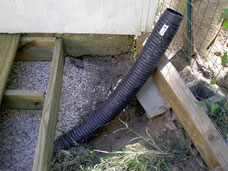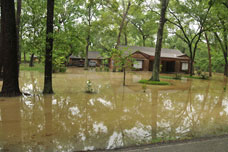CONSIDERATIONS FOR A WET LAWN
MINIMIZE TRAFFIC

AERATE AND AMEND
The more air space soil has, the higher its water carrying capacity will be. Aerated soils can hold more water, and water will move through them more readily without the soil becoming compacted. An aerator takes narrow plugs of dirt out of your lawn, allowing water, nutrients and air to move deeper into the soil. Rent an aerator every two or three years. It will only take a couple of hours work, depending upon the size of your lawn, and will be time well spent.
Soil amendments will also improve aeration and the water holding capacity of your lawn. A good quality screened compost or topsoil can be used as a thin topdressing for your lawn on an annual basis. This is a slower route to improved soil quality, but it works well in conjunction with aerating.
ADD DRAINAGE

REGRADE YOUR LAWN
Take a close look at the surface of your lawn or bring in a landscaping professional that can help you evaluate surface drainage. If several different areas drain onto your yard and there is little opportunity for water to flow off, it can make your lawn much wetter than it needs to be. Depending on your situation, a regrading project can be very simple or rather complex. It’s the type of work best done by a landscaping company.
Not every winter has weather that results in wet, soggy lawns in the spring. When it does happen, it takes some of the fun out of spring and warmer weather. If you are worried about the condition of your wet yard, consider some of the options above and talk to us about the best approach to fix your soggy, wet lawn.
- WHY TRUST IS SO IMPORTANT TO US - December 15, 2019
- MORE ON LANDSCAPE LIGHTING - February 16, 2019
- 5 Ways Landscaping Can Increase Your Home Value - January 5, 2019
